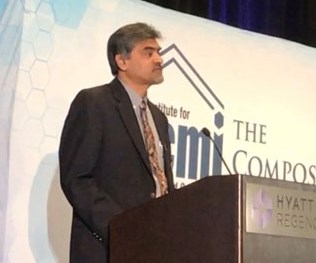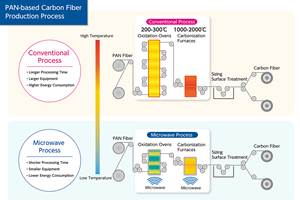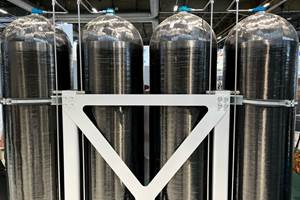Developing new solutions for noise, vibration and harshness
Several recent IACMI partner projects focus on technology innovation related to challenges in noise, vibration and harshness (NVH) in vehicle design.

Uday Vaidya, Chief Technology Officer at IACMI
IACMI — The Composites Institute (Knoxville, Tenn., U.S.) and its project partners have been making significant progress over the past five years, following IACMI’s technology roadmap, in areas already discussed in previous columns this year, such as efforts to reduce the embodied energy of composites, improvements to composites’ recyclability and new solutions for multimaterial joining. Another focus for IACMI projects is reduction of noise, vibration and harshness (NVH) in automotive applications.
Despite enabling energy savings and emissions reductions from lower fuel levels, automotive lightweighting can contribute to unfavorable NVH in vehicle operation.
NVH is most commonly managed through absorption of acoustic energy by physical structures. The comparison of effectiveness of energy absorption between materials is determined by complex relations between physical and design factors, such as mechanical properties, density, intrinsic structure, as well as component geometry, connections and loading. Vehicle mass reduction can be a zero-sum game for automakers in cases where a light material is directly substituted in an existing design, but additional mass is required to meet NVH requirements. Addressing NVH early in the design for a new material can help realize a positive impact on weight, cost and energy.
With respect to IACMI’s goals, NVH challenges directly impact the overall cost of deploying carbon fiber-reinforced polymers (CFRP). While NVH challenges are embodied in passenger sound and ride quality in automotive applications, acoustic energy can also negatively impact rotor rotation speeds in wind turbine applications. Managing NVH costs is easiest if addressed early in product and process design using predictive modeling tools and integrated design approaches.
Considering all aspects of advanced composites integration is important for implementation into the automotive market.
IACMI and its members have identified a range of topical focus areas important for achieving IACMI’s technical goals while also addressing NVH challenges:
- Novel fabrication techniques and advanced lay-up methods can enable highly tailored structures and fiber orientations that improve NVH quality in composites.
- Comprehensive simulation tools and software suites can help address NVH challenges throughout the composite lifecycle — from design, to validation, initial manufacture, use through end-of-life (EOL), recycling and reuse.
- Dynamic material and structural characterization methods improve the accuracy of predictive modeling tools to better control NVH performance costs during early design stages.
- Systems-level design and process modeling approaches permit greater control of early-stage NVH performance through concurrent simulation-based experimental design of materials, components and structures, and their respective manufacturing processes.
- Multimaterial design methods and joining technologies can simultaneously permit the selective integration of new high-performance composites while helping to solve core NVH issues.
- Unique fiber architectures, additively manufactured structural cores, and embedded sensor technologies can help solve NVH issues for automotive and wind turbine applications.
To help guide industry-led technology demonstration projects toward achievable NVH solutions, IACMI and its members co-developed a strategy with the following objectives:
- Align NVH project proposals with industry needs. Industry stakeholders recognize that increased NVH performance helps to boost the adoption and market pull for advanced composites. IACMI will continue to support project opportunities that propose to solve core NVH challenges and reduce downstream change-related costs.
- Proactively address NVH in early product and process design to reduce change-related costs. Integrated design approaches that combine predictive modeling tools with dynamic material/structural characterization approaches can help composites manufacturers proactively control NVH performance costs during the early stages of product design. Demonstrating these cost savings will help promote and accelerate the adoption of composite materials for automotive and wind turbine applications.
- Leverage IACMI’s unique vertically integrated partnerships. NVH challenges are driven by many systems factors, including multi-component composites structures, adhesives, and intermediates, and their respective manufacturing processes. IACMI will continue to facilitate collaborative relationships across the composites manufacturing supply chain to address key NVH needs while delivering lighter composites for automotive and other application markets.
Considering all aspects of advanced composites integration in novel ways – such as how NVH impacts the vehicle and user experience – is important for the implementation of composites into the automotive market. Through better understanding the factors that impact NVH, IACMI can lead industry research to solve problems and continue to drive lightweighting of the automotive sector.
Related Content
Microwave heating for more sustainable carbon fiber
Skeptics say it won’t work — Osaka-based Microwave Chemical Co. says it already has — and continues to advance its simulation-based technology to slash energy use and emissions in manufacturing.
Read MoreHexagon Purus Westminster: Experience, growth, new developments in hydrogen storage
Hexagon Purus scales production of Type 4 composite tanks, discusses growth, recyclability, sensors and carbon fiber supply and sustainability.
Read MoreRecycling hydrogen tanks to produce automotive structural components
Voith Composites and partners develop recycling solutions for hydrogen storage tanks and manufacturing methods to produce automotive parts from the recycled materials.
Read MoreNatural fiber composites: Growing to fit sustainability needs
Led by global and industry-wide sustainability goals, commercial interest in flax and hemp fiber-reinforced composites grows into higher-performance, higher-volume applications.
Read MoreRead Next
“Structured air” TPS safeguards composite structures
Powered by an 85% air/15% pure polyimide aerogel, Blueshift’s novel material system protects structures during transient thermal events from -200°C to beyond 2400°C for rockets, battery boxes and more.
Read MoreDeveloping bonded composite repair for ships, offshore units
Bureau Veritas and industry partners issue guidelines and pave the way for certification via StrengthBond Offshore project.
Read MoreVIDEO: High-volume processing for fiberglass components
Cannon Ergos, a company specializing in high-ton presses and equipment for composites fabrication and plastics processing, displayed automotive and industrial components at CAMX 2024.
Read More




















